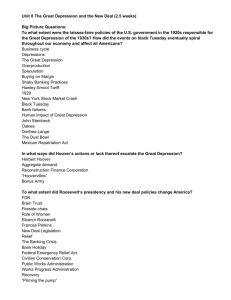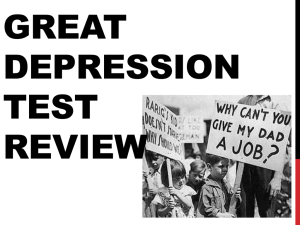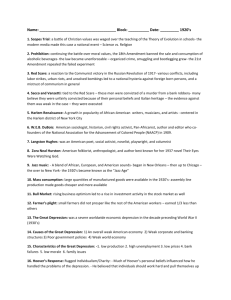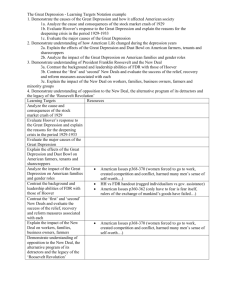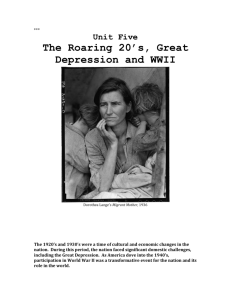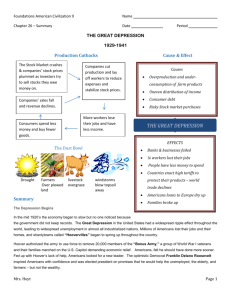ch.14 test
advertisement
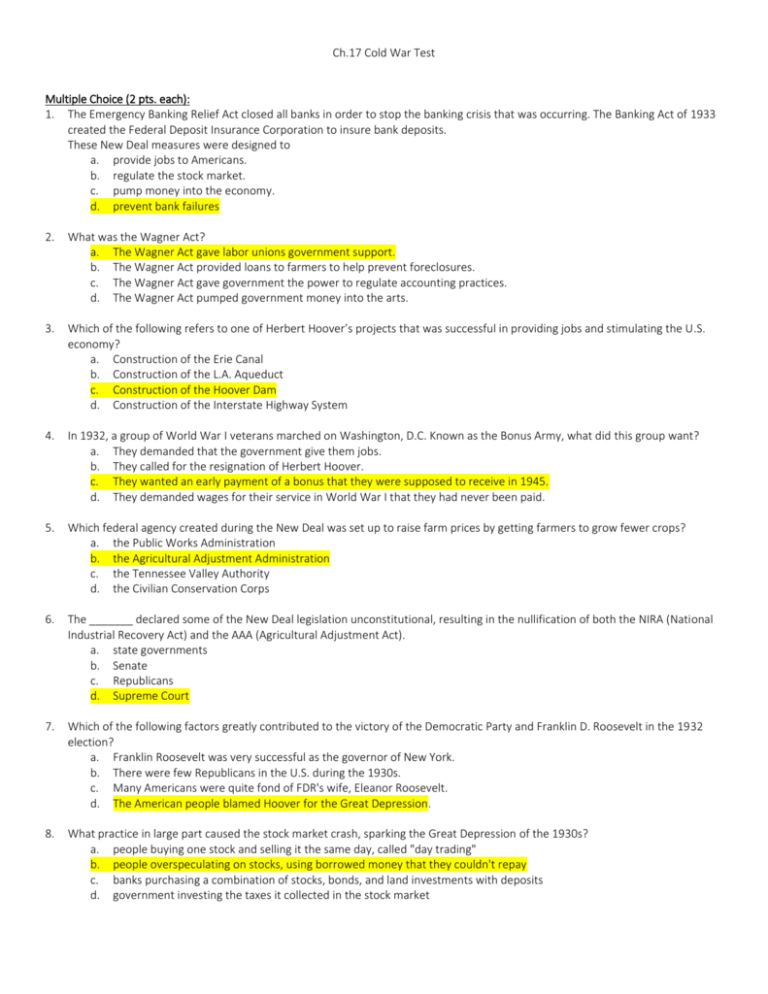
Ch.17 Cold War Test Multiple Choice (2 pts. each): 1. The Emergency Banking Relief Act closed all banks in order to stop the banking crisis that was occurring. The Banking Act of 1933 created the Federal Deposit Insurance Corporation to insure bank deposits. These New Deal measures were designed to a. provide jobs to Americans. b. regulate the stock market. c. pump money into the economy. d. prevent bank failures 2. What was the Wagner Act? a. The Wagner Act gave labor unions government support. b. The Wagner Act provided loans to farmers to help prevent foreclosures. c. The Wagner Act gave government the power to regulate accounting practices. d. The Wagner Act pumped government money into the arts. 3. Which of the following refers to one of Herbert Hoover’s projects that was successful in providing jobs and stimulating the U.S. economy? a. Construction of the Erie Canal b. Construction of the L.A. Aqueduct c. Construction of the Hoover Dam d. Construction of the Interstate Highway System 4. In 1932, a group of World War I veterans marched on Washington, D.C. Known as the Bonus Army, what did this group want? a. They demanded that the government give them jobs. b. They called for the resignation of Herbert Hoover. c. They wanted an early payment of a bonus that they were supposed to receive in 1945. d. They demanded wages for their service in World War I that they had never been paid. 5. Which federal agency created during the New Deal was set up to raise farm prices by getting farmers to grow fewer crops? a. the Public Works Administration b. the Agricultural Adjustment Administration c. the Tennessee Valley Authority d. the Civilian Conservation Corps 6. The _______ declared some of the New Deal legislation unconstitutional, resulting in the nullification of both the NIRA (National Industrial Recovery Act) and the AAA (Agricultural Adjustment Act). a. state governments b. Senate c. Republicans d. Supreme Court 7. Which of the following factors greatly contributed to the victory of the Democratic Party and Franklin D. Roosevelt in the 1932 election? a. Franklin Roosevelt was very successful as the governor of New York. b. There were few Republicans in the U.S. during the 1930s. c. Many Americans were quite fond of FDR's wife, Eleanor Roosevelt. d. The American people blamed Hoover for the Great Depression. 8. What practice in large part caused the stock market crash, sparking the Great Depression of the 1930s? a. people buying one stock and selling it the same day, called "day trading" b. people overspeculating on stocks, using borrowed money that they couldn't repay c. banks purchasing a combination of stocks, bonds, and land investments with deposits d. government investing the taxes it collected in the stock market 9. Which of the following New Deal measures is still part of American life today? a. the Agricultural Adjustment Act b. the Works Progress Administration c. the National Industrial Recovery Act d. the Social Security Act 10. Which New Deal program employed people to build roads, public housing, and sewers? a. Social Security b. Agricultural Adjustment Act c. Federal Deposit Insurance Corporation d. Public Works Administration 11. The Securities and Exchange Commission, formed in 1934 during the First New Deal, still operates today by a. insuring deposits in bank accounts. b. providing work in arts, theater, and literary projects. c. distributing millions of dollars of direct aid to unemployed workers. d. regulating the stock market and restricting margin buying. 12. The term "Okie" was used to describe people who migrated away from Oklahoma during the Dust Bowl of the 1930s. This migration was famously depicted in which of the following books? a. The Great Gatsby b. East of Eden c. The Winter of Our Discontent d. The Grapes of Wrath 13. How did the Great Depression change the role of government in America? a. The role of government greatly expanded. b. State governments became more important than the federal government. c. The federal government decreased in size and scope. d. The federal government became less involved in the economy 14. The stock market crash on _______ caused widespread unemployment and bank failure and was the first symptom of the impending Great Depression. a. June 6, 1941 b. September 1, 1931 c. December 7, 1927 d. October 29, 1929 15. The man pictured above captured the 1928 election and was president during the initial years of the great depression. Who is he? a. Warren Harding b. Dwight D. Eisenhower c. Herbert Hoover d. Howard Taft 16. “Hoovervilles” during the Great Depression consisted of a. groups of makeshift homes in shantytowns. b. deserted towns filled with foreclosed businesses. c. pockets of the country that supported President Hoover. d. poor urban immigrant communities. 17. The Supreme Court declared many New Deal programs unconstitutional. What did President Roosevelt attempt to do in response to these Supreme Court decisions? a. sign an executive order that nullified Supreme Court decisions b. pass laws again after they had been declared unconstitutional c. amend the Constitution to restrict the Supreme Court's power d. make a bill that placed more justices on the Supreme Court 18. Which of the following acts as a barometer to check the health of the stock market? a. Nasdaq b. Dow Jones Industrial Average c. Wall St. Journal d. None of the above 19. Which of the following statements is true about the New Deal? a. The New Deal helped the economy to slowly recover. b. The New Deal made the economic Depression slightly worse. c. The New Deal quickly ended the Great Depression. d. The New Deal did little to change the stagnant economy. 20. What was the "First Hundred Days"? a. The time in which the United States military mobilized following the attack on Pearl Harbor. b. The special congressional session called by President Roosevelt after his inauguration to initiate New Deal legislation. c. The time period directly following the stock market crash in 1929, during which banks failed and factories closed at record rates. d. Hoover's plan for economic recovery in which public works programs built dams and Congress passed legislation raising tariffs on foreign goods. 21. Franklin Roosevelt's New Deal programs, such as the Tennessee Valley Authority and the Civilian Conservation Corp, were designed to a. give jobs to the unemployed. b. get the elderly social security. c. distribute welfare aid to families. d. rebuild the failed banks of the U.S. 22. Which of the following was a cause of the Great Depression? a. Farming crisis b. Easy credit c. Unequal distribution of income d. All of the above 23. Which of the following industries grew explosively during the 1920s? a. railroad b. health care c. automobile d. meat-packing 24. President _______ developed the New Deal, a domestic program of public works programs and farm aid, to help the United States through the Great Depression. a. Theodore Roosevelt b. Lyndon B. Johnson c. Franklin D. Roosevelt d. Woodrow Wilson 25. Which federal program hired young men to do jobs such as planting trees and building parks? a. the National Recovery Administration b. the Federal Deposit Insurance Corporation c. the Federal Housing Administration d. the Civilian Conservation Corps 26. • Drought • Over-farming and removal of vegetation • Numerous foreclosed farms • Numerous dust storms The factors above describe the conditions during the Dust Bowl. Which region was most affected by the Dust Bowl? a. the Northeast b. the Pacific Northwest c. the West Coast d. the Great Plains 27. Which factor contributed to low agricultural prices at the onset of the Great Depression? a. shortages in farm production b. increases in wages c. surpluses in farm production d. decreases in American population 28. Which New Deal program hired men to build a series of dams to prevent flooding and sell electricity in Appalachia? a. Tennessee Valley Authority b. National Youth Administration c. Federal Emergency Relief Act d. Agricultural Adjustment Act 29. • created a minimum wage • established a forty-hour work week • prohibited child labor The items listed in the box above were all part of which legislation that went into effect during the Great Depression? a. the Agricultural Adjustment Act b. the Fair Labor Standards Act c. the Emergency Banking Act d. the National Industrial Recovery Act 30. The picture above was a car used by migrants from Oklahoma, called Okies, during the Dust Bowl of the 1930s. People from Oklahoma migrated mostly to which of the following states? a. Michigan b. California c. North Dakota d. Texas 31. One New Deal program aimed to protect citizens by establishing the Federal Deposit Insurance Corporation. In what way does the FDIC protect citizens? a. If a bank fails, the government will work to reestablish it. b. Members of banks are guaranteed protection for their money. c. Banks are required to lower interest rates in economic troubles. d. Citizens are given a higher interest on large deposits of money 32. What did the Smoot-Hawley Tariff of 1930 do? a. It raised tariffs on imported goods. b. It lowered tariffs on imported and exported goods. c. It lowered tariffs on imported goods. d. It raised tariffs on exported goods 33. • Warren Harding • Calvin Coolidge • Herbert Hoover How a. b. c. d. did the presidents above contribute to the prosperity of the 1920s? They were largely inactive and allowed businesses to grow unregulated. They opened new markets for American products overseas by employing "dollar diplomacy." They invested large sums of American tax dollars giving incentives to business owners. They carried the ideals of the Progressive era into the 1920s and regulated industry. 34. What is the name given to people who buy stocks or real estate with the hopes of selling it for a profit in the future at a profit? a. imperialists b. bootleggers c. philanthropists d. speculators 35. Which of the following were some of the struggles faced by American farmers during the 1920s? a. decreases in the amount of crops grown on farms b. falling crop prices and large amounts of debt c. increased competition from imported crops d. lack of workers to perform labor on farms 36. Which of the following best describes the U.S. economy during Calvin Coolidge's administration? a. There was an economic depression in which the country faced a high rate of unemployment. b. There was a great deal of prosperity as businesses grew, but some people still struggled financially. c. The economy experienced rapid inflation and the currency was devalued. d. The economy was quite stable as there was very little economic growth or decline. 37. What does buying stock on margin mean? a. buying stock for a fraction of its cost and borrowing against future profits b. buying stock after receiving a tip that the stock price will go up c. buying stock on credit, putting no money down initially d. buying stock on behalf of another person 38. Which of the following best describes President Hoover’s approach to dealing with the new deal? a. Felt the government should play a limited role in solving the nation’s problems b. Favored government spending to rejuvenate the nation’s economy c. Opposed federal relief/welfare to the needy d. Both A & C 39. The shaded region in the map above is of the Great Plains. Which of the following events occurred in this region during the 1920s30s that impacted farmers in the Great Depression? a. Japanese Attack on Kansas City, KS b. Building of TVA projects c. Dust Bowl Storms d. None of the above 40. Which of the following New Deal programs was FDR’s most important and has the longest lasting impact on the lives of Americans? a. Soil Conservation Service b. Agriculture Adjustment Act c. Securities and Exchange Commission d. Social Security 41. During the Great Depression President Roosevelt was forced to practice ___________________, where the government spent more than they received in income. a. Buying on Margin b. Deficit Spending c. Crop Rotation d. 10-10-10 Taxing 42. Which of the following was NOT one of FDR’s New Deal goals? a. Relief for the needy b. Economic Recovery c. Decrease working hours d. Financial reform 43. The man pictured above was a U.S. Senator from Louisiana that was a major critic of FDR and planned to challenge him in the 1936 election before being assassinated. Who is he? a. Father Charles Coughlin b. Huey Long c. Billy Sunday d. Rand Paul 44. Which of the following constitutional amendments were ratified during FDR’s first term that legalized the sale of alcohol in the U.S. by repealing the 18th Amendment? a. 21st Amendment b. 34th Amendment c. 5th Amendment d. 19th Amendment 45. Which of the following best describes the consequences of FDR not launching his 3rd New Deal in 1937 after being pressured by Congress to decrease deficit spending? a. The U.S. economy steadily rose without government assistance b. Unemployment rose significantly without government assistance c. FDR was not re-elected to his 3rd term d. All of the above



